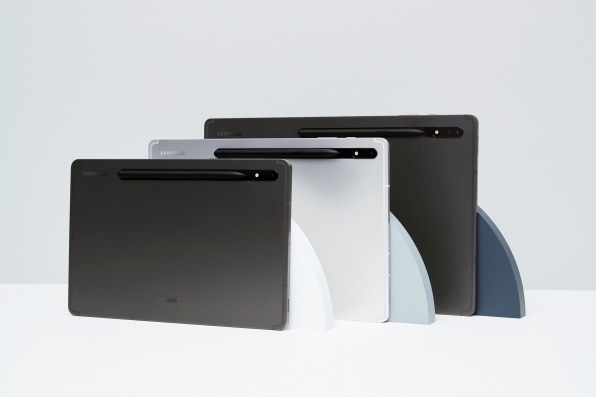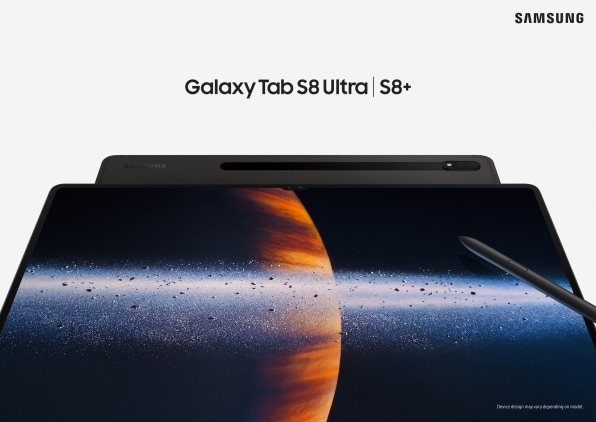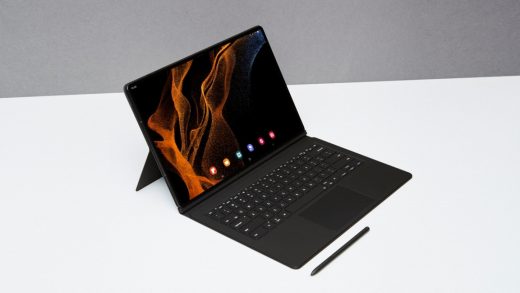Samsung made the giant tablet that Apple hasn’t. What’s next?
Amid Samsung’s new lineup of flagship tablets for 2022, the Galaxy Tab S8 Ultra stands out for an obvious reason.
With a 14.6-inch screen, it’s Samsung’s largest Android tablet to date and one that dwarfs even Apple’s 12.9-inch iPad Pro. (Both are 7.7 inches tall in landscape mode, but the Tab S8 Ultra is 2.6 inches wider.) For all Apple’s talk of tablets replacing laptops, Samsung’s is actually large enough to stand in for a mid-sized notebook. (The larger iPad Pro’s screen is still a skosh smaller than the one on a 13-inch MacBook Air.)
The announcement is part of a broader launch for Samsung that also includes the 11-inch Galaxy Tab S8, the 12.4-inch Galaxy Tab S8+, and a trio of Galaxy S22 phones. (The largest of those phones, Samsung’s Galaxy S22 Ultra, is a spiritual successor to the Galaxy Note, built-in stylus and all.)
But while the oversized tablet hardware looks intriguing, Samsung spent little time discussing the software, and how it’s approaching Android is a good fit for such a large screen. That’s a problem for a device that starts at $1,100, and will have to compete with highly capable Windows PCs and Macs on the productivity front.
A tablet without a cause
Screen size aside, the Tab S8 Ultra is not markedly different from the smaller Tab S8+. They both have octa-core processors, 120-Hz AMOLED displays, dual rear cameras, and in-display fingerprint readers, and they both have optional book cover keyboards and kickstands to effectively turn them into laptops.
The biggest differentiator other than screen size is that the Tab S8 Ultra has a front camera notch, making room for both wide and ultrawide 12-megapixel lenses. Therein lies Samsung’s biggest argument for the larger screen: It’s meant for video chat, and the company says it worked with partners such as Google, WebEx, and Bluejeans to make sure their conferencing software works well on the Tab S8 Ultra.
Still, I was hoping to hear more from Samsung about what else this jumbo-sized tablet would offer that touchscreen Windows devices or Chromebooks don’t. While I understand the appeal of the hardware—a slick, lightweight device with a beautiful display and stylus—the software story still doesn’t seem fleshed out.

In a pre-recorded press presentation, Samsung pointed to the painting/illustration app Clip Studio Paint as the kind of software that shines on the Tab S8 Ultra. It also briefly showed a nifty integration with Samsung phones, in which the smaller screen becomes a palette for the larger one. Beyond that, however, the use cases aren’t as well-defined, and the company didn’t call out any other developer partnerships or examples of third-party apps that make use of all that real estate.
All of which left me wondering why you would buy this device instead of an out-and-out laptop—perhaps with a convertible design like Lenovo’s Yoga series—or a Windows tablet such as Microsoft’s Surface Pro. A brief group Q&A with Samsung after its presentation didn’t leave time to dig into these questions.
In a follow-up email, a Samsung spokesperson said its research shows customers want larger screens, and that a greater proportion of customers have been buying mice and keyboards with its larger tablets. As for the merits of tablets vs. laptops, the company merely noted that it gives customers a choice by selling Windows laptops and Chromebooks—though not with the same tablet hardware as the Tab S8 line.
Waiting for Google
To be fair, the challenges facing a large tablet like the Galaxy Tab S8 Ultra aren’t entirely of Samsung’s own making.
On larger screens, Android is in a limbo state after years of neglect by Google. While Apple has made big investments into iPadOS over the past few years, Google’s Android updates have done little to make the operating system work better on larger screens, as the company seemed more focused on building out ChromeOS as a platform for tablets.
Only recently has Google turned its attention back around to Android again. The company formed an “Android Tablets” initiative over the past year and—as JR Raphael uncovered for Computerworld—brought one of Android’s founders back as CTO for Android tablets. As 9to5Google’s Abner Li reports, and it’s now working on its own set of big-screen optimizations with Android 12L. In a job posting for a senior Android tablet engineer, Google wrote that “the future of computing is shifting towards more powerful and capable tablets.”

None of that helps Samsung in the present. While Samsung has built many of its own Android tablet optimizations independently of Google—including an array of windowing and split-screen modes for apps—the Galaxy Tab S8 Ultra won’t ship with Android 12L.
Meanwhile, Android still needs a lot more first-class tablet apps. Adobe’s full tablet versions of Photoshop and Illustrator remain exclusive to the iPad, as do notable alternatives such as Procreate and Affinity Photo. The Android version of the video editor LumaFusion is still in early development, and there’s no Android version of Notability, my favorite iPad app for handwritten notes. Bringing Android more in line with iPadOS on the app front is not something that can be done overnight.
And yet, part of me still admires Samsung for putting the Galaxy Tab S8 Ultra out there anyway. Along with having released as many ambitious and capable Android tablets as anyone, the company has a long history of releasing bleeding-edge hardware, and while the products aren’t always successful, they help show what might be possible once the software is more refined and the market is ready. Samsung’s foray into foldables is the most recent example, but I’m also thinking back to the Galaxy Note Pro, a 12.2-inch tablet that arrived in early 2014 and helped set the stage for Apple’s 12.9-inch iPad Pros a year and a half later.
Perhaps in a few years, we’ll look back at the Galaxy Tab S8 Ultra in the same way.
(34)



